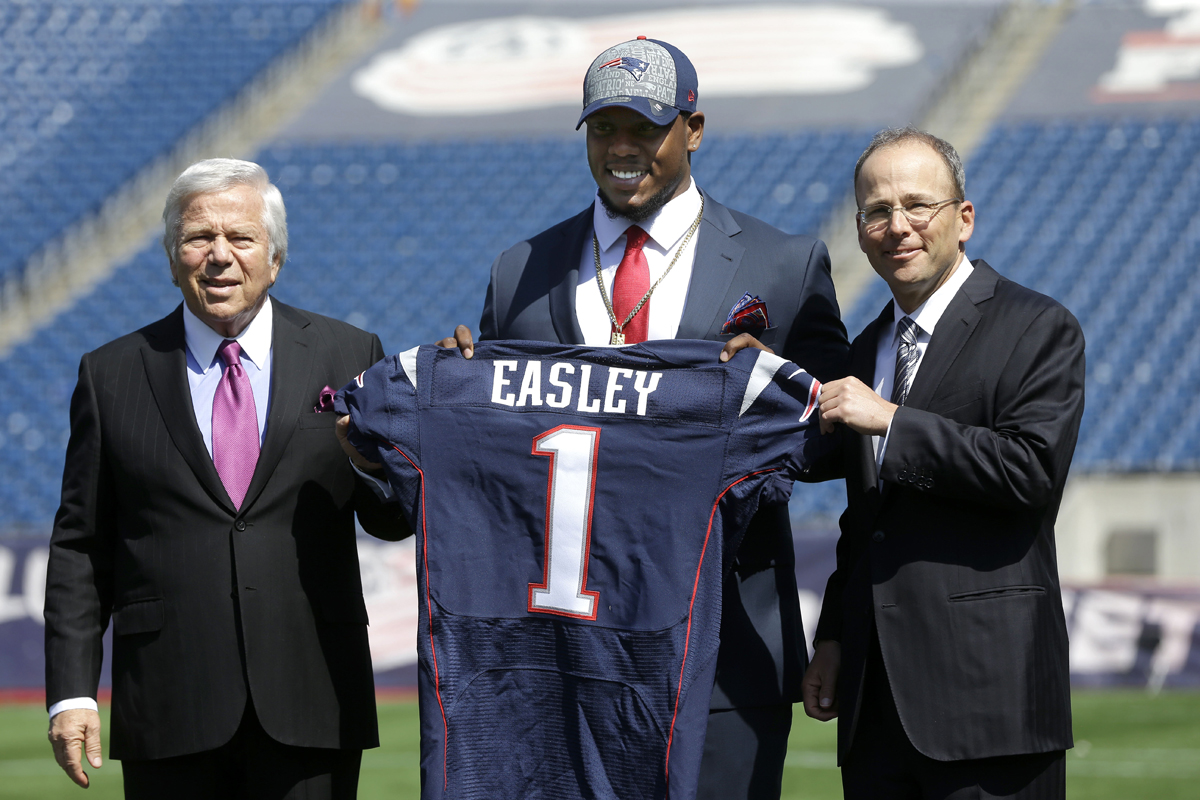Did the Patriots Do the Unexpected in the NFL Draft?

Photo via Associated Press
The Patriots made nine picks in the 2014 NFL draft between Thursday and Saturday, starting with a player coming off of his second ACL tear in three seasons and highlighted by the highest-drafted quarterback in the Bill Belichick era.
Some aspects of this year’s draft followed precedent with more picks and additions from Florida and Rutgers while the team’s quiet night on the trade front may be a sign of an emerging trend.
While the Patriots’ nine picks fall squarely between the hashmarks—the team has made 134 selections since Belichick took over in 2000, or 8.9 per year—the lone trade comes as something of a surprise in what many considered to be the deepest draft in recent memory. Mike Reiss expected the Patriots to do the unexpected (it’s always hard to know what that means, exactly), but New England probably accomplished that with their picks.
According to Reiss, Belichick had made a total of 52 draft-day trades in 14 years, including 21 between 2009 and 2012. But 2014 marked the second consecutive year the Patriots have made just one draft-day pick swap. Perhaps Belichick overwhelmingly liked the players available in the slots he started with, or perhaps teams around the league have not been willing to make the kind of deals the Patriots have been so fond of, such as trading a pick for a higher pick in the subsequent draft. Either way, after making an average of more than five draft-day pick trades the previous four years, it’s been strange to see the Patriots so regularly submit a draft card in their originally allotted draft slot.
Of course, who the Patriots selected has created far more buzz. With the 29th pick, New England selected Dominque Easley, a decision Reiss called the team’s riskiest first-round selection in memory. Easley became the seventh Florida player drafted by Belichick and was later joined by teammate Jon Halapio, who was drafted with the third pick of the sixth round. Some hoped optimistically that Easley would be available late in the second round, but the Patriots were not the only team who coveted Easley at the end of the first round.
The pick heard around the Northeast, however, came in the second round, when the Patriots drafted Jimmy Garoppolo, a quarterback from Eastern Illinois. Garoppolo became the eighth quarterback taken in the draft by Belichick and might one day replace the first quarterback Belichick drafted. That will depend considerably both on how long Tom Brady continues to play at a high level and whether the Patriots can groom Garoppolo into a player capable of succeeding Brady in New England. As the highest drafted quarterback under Belichick and because of the opportunity cost of taking a second-round quarterback, Garoppolo will be closely scrutinized. Of the six other signal callers selected to back up Brady, only Matt Cassell has started an NFL game, though it remains to be seen if Ryan Mallett will eventually earn himself a starting spot. And while the Patriots didn’t draft him, Brian Hoyer is another quarterback the Patriots have groomed into a fringe starter. Nonetheless, the pressure to develop Garoppolo into Brady’s successor, or future early draft picks will be considerable.
The team’s only trade came in the third round, with the Patriots sliding back 12 slots from the late third into the fourth round while acquiring a sixth-round pick. Belichick selected a pair of offensive lineman with the picks, taking Florida State center Bryan Stork with the 105th pick and Halapio with the third pick of the sixth round.
Since 2000, Belichick has orchestrated 48 draft-pick trades (the number increases to 52 when you include picks-for-players deals). Thirty-two of those trades are either trades back in the current draft to accumulate more picks or swapping current picks for higher future picks. But if teams are hesitant to make these deals, will it ultimately hurt the Patriots? Simply, yes. A good example of the Patriots’ patience paying off is the team’s 2010 swap with the Panthers when New England traded the 89th pick of the 2010 draft for a 2011 third-round pick that turned into the 33rd overall selection. Both teams ultimately selected players that have had underwhelming professional careers—Amanti Edwards and Ras-I Dowling, respectively—but teams would vastly prefer to be in the Patriots’ draft position. Those trade opportunities, which often presented themselves to the Patriots five years ago, do not seem to be as prevalent today as the rest of the league has adjusted to Belichick’s draft-day mastery. Belichick may find new value somewhere else in the draft, but it appears his days of swapping immediate picks for more valuable picks in the future are over.
With the draft and much of free agency concluded, the next date for Patriots fans to circle on the calendar is May 27, when players and coaches will report for organized team activities (OTA). Thanks to the early May draft, that’s just a couple of weeks away. In the meantime, try to avert your eyes from the slew of Patriots post-draft grades flooding the net—they aren’t all that optimistic.


